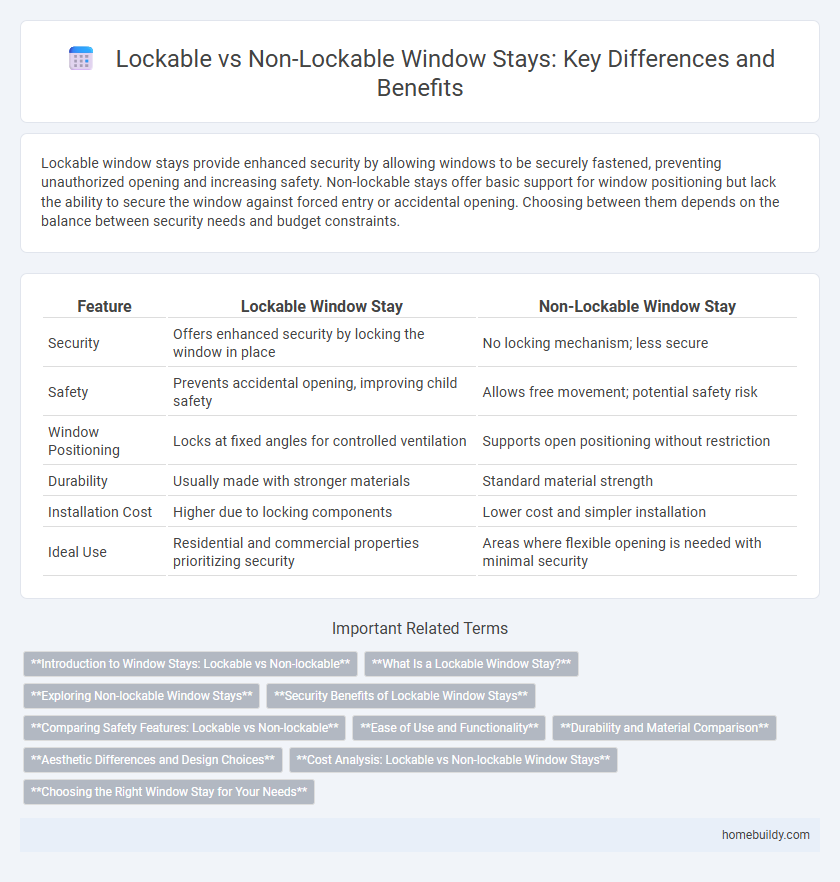Lockable window stays provide enhanced security by allowing windows to be securely fastened, preventing unauthorized opening and increasing safety. Non-lockable stays offer basic support for window positioning but lack the ability to secure the window against forced entry or accidental opening. Choosing between them depends on the balance between security needs and budget constraints.
Table of Comparison
| Feature | Lockable Window Stay | Non-Lockable Window Stay |
|---|---|---|
| Security | Offers enhanced security by locking the window in place | No locking mechanism; less secure |
| Safety | Prevents accidental opening, improving child safety | Allows free movement; potential safety risk |
| Window Positioning | Locks at fixed angles for controlled ventilation | Supports open positioning without restriction |
| Durability | Usually made with stronger materials | Standard material strength |
| Installation Cost | Higher due to locking components | Lower cost and simpler installation |
| Ideal Use | Residential and commercial properties prioritizing security | Areas where flexible opening is needed with minimal security |
Introduction to Window Stays: Lockable vs Non-lockable
Window stays provide essential support and control for window operation, with lockable window stays offering enhanced security by allowing the window to be fixed in various open positions. Non-lockable window stays enable smooth movement without a locking mechanism, suitable for ventilation where security is not a primary concern. Choosing between lockable and non-lockable stays depends on the balance of security needs and ventilation preferences in building design.
What Is a Lockable Window Stay?
A lockable window stay is a security feature designed to secure windows in a fixed position while preventing unauthorized opening. Unlike non-lockable stays that allow free movement, lockable stays incorporate a locking mechanism to enhance safety and control ventilation. This type of window stay is commonly used in residential and commercial properties to improve security without compromising window functionality.
Exploring Non-lockable Window Stays
Non-lockable window stays offer a simple and cost-effective solution for controlling window opening angles without the need for security features. These stays are ideal for ventilation purposes, allowing easy adjustment while maintaining structural support and preventing excessive movement due to wind. Their lightweight design and ease of installation make them suitable for residential and commercial applications where locking mechanisms are not a priority.
Security Benefits of Lockable Window Stays
Lockable window stays provide enhanced security by preventing unauthorized access and strengthening window resistance against forced entry. They offer an effective deterrent against break-ins by securely locking the window at multiple points, reducing vulnerabilities compared to non-lockable stays. With lockable stays, homeowners and businesses benefit from increased protection and peace of mind, especially in ground-level or easily accessible windows.
Comparing Safety Features: Lockable vs Non-lockable
Lockable window stays provide enhanced security by preventing unauthorized opening, making them ideal for homes and offices requiring increased safety measures. Non-lockable stays offer basic functionality for holding windows open but lack security features that deter intruders or accidental openings. Choosing lockable window stays significantly reduces risks of break-ins and accidental falls compared to non-lockable options.
Ease of Use and Functionality
Lockable window stays offer enhanced ease of use by providing secure positioning and preventing accidental closure, ensuring better control over window ventilation and safety. Non-lockable stays allow for simple operation but may lack the stability and security features, potentially leading to unwanted movement in windy conditions. The lock mechanism in lockable stays improves functionality by enabling users to set and maintain preferred window angles confidently.
Durability and Material Comparison
Lockable window stays typically feature heavy-duty stainless steel or reinforced aluminum, enhancing durability and resistance to corrosion compared to non-lockable stays that often use lighter metals or plastic components. The robust materials in lockable stays provide superior strength, making them ideal for high-traffic or security-sensitive applications. Non-lockable stays, while more cost-effective, tend to have shorter lifespans due to their less resilient materials and vulnerability to wear and tear.
Aesthetic Differences and Design Choices
Lockable window stays offer a sleek, integrated appearance with hidden locking mechanisms that enhance the window's overall aesthetic by maintaining clean lines and minimizing visible hardware. Non-lockable stays, often simpler and more utilitarian, can create a more traditional or industrial look due to exposed components. Design choices favor lockable stays in modern architectural styles emphasizing minimalism, while non-lockable stays suit rustic or functional designs prioritizing practicality over form.
Cost Analysis: Lockable vs Non-lockable Window Stays
Lockable window stays typically incur higher initial costs due to integrated locking mechanisms and enhanced materials designed for security and durability, while non-lockable stays offer a more budget-friendly option with simpler construction. Maintenance expenses for lockable stays may be lower over time as they reduce the risk of forced entry and damage, whereas non-lockable stays might require more frequent replacements or repairs. Factoring in security benefits, lockable stays often provide better long-term value despite their premium price compared to non-lockable alternatives.
Choosing the Right Window Stay for Your Needs
Choosing the right window stay depends on security requirements and ease of use; lockable window stays provide enhanced safety by preventing unauthorized opening, making them ideal for ground-floor or high-risk areas. Non-lockable stays offer simpler operation and are suitable for rooms where ventilation and convenience take priority over security. Assessing factors like window type, location, and safety concerns ensures you select a window stay that balances functionality and protection effectively.
Lockable window stay vs Non-lockable stay Infographic

 homebuildy.com
homebuildy.com